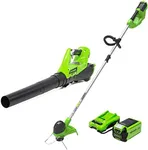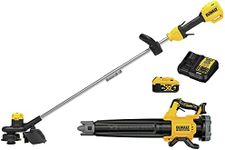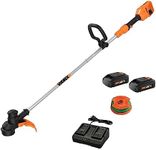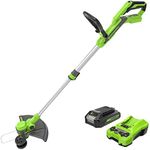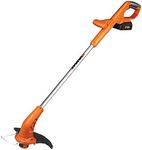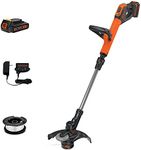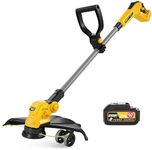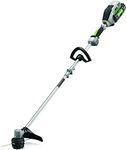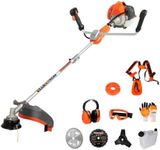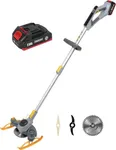Buying Guide for the Best Battery Powered Weed Eater
Choosing the right battery-powered weed eater can make your yard work much easier and more efficient. When selecting a weed eater, it's important to consider several key specifications to ensure you get a model that fits your needs. Understanding these specs will help you make an informed decision and find a weed eater that is powerful enough for your tasks, easy to handle, and has a battery life that suits your working habits.Battery VoltageBattery voltage indicates the power output of the weed eater. Higher voltage generally means more power, which can be useful for tougher weeds and larger areas. Weed eaters typically range from 18V to 80V. For light trimming and small yards, a lower voltage (18V-24V) may be sufficient. For medium to large yards with thicker weeds, consider a mid-range voltage (36V-40V). For heavy-duty tasks and large properties, a higher voltage (56V-80V) will provide the necessary power.
Battery Capacity (Ah)Battery capacity, measured in ampere-hours (Ah), determines how long the weed eater can run on a single charge. Higher capacity batteries will last longer but may also be heavier. Common capacities range from 2.0Ah to 5.0Ah or more. For small yards or quick jobs, a lower capacity (2.0Ah-2.5Ah) may be adequate. For larger yards or extended use, a higher capacity (4.0Ah-5.0Ah) will reduce the need for frequent recharging.
Cutting SwathThe cutting swath is the width of the area the weed eater can cut in a single pass. A wider cutting swath means you can cover more ground quickly, but it may also be harder to maneuver in tight spaces. Cutting swaths typically range from 10 inches to 16 inches. For small, intricate areas, a narrower swath (10-12 inches) is ideal. For larger, open areas, a wider swath (14-16 inches) will help you finish faster.
WeightThe weight of the weed eater affects how easy it is to handle and use for extended periods. Lighter models are easier to maneuver and less tiring, but they may have less power or battery life. Weed eaters can weigh anywhere from 5 to 15 pounds. If you have a small yard or need to use the tool for long periods, a lighter model (5-8 pounds) is preferable. For more demanding tasks, a slightly heavier model (9-15 pounds) may offer better performance.
Adjustability and ErgonomicsAdjustability and ergonomics refer to how comfortable and customizable the weed eater is to use. Features like adjustable handles, telescoping shafts, and rotating heads can make the tool more comfortable and versatile. Look for models with ergonomic designs that reduce strain on your hands and back. If you have specific comfort needs or plan to use the weed eater for long periods, prioritize models with these adjustable features.
Noise LevelThe noise level of a weed eater can impact your comfort and that of your neighbors. Battery-powered models are generally quieter than gas-powered ones, but there can still be variations. Noise levels are measured in decibels (dB). If you are sensitive to noise or have close neighbors, look for models with lower noise levels, typically around 60-70 dB. For less noise-sensitive environments, this may be less of a concern.
Charging TimeCharging time is the duration it takes to fully recharge the battery. Faster charging times mean less downtime between uses. Charging times can range from 30 minutes to several hours. If you need to use the weed eater frequently or for long periods, look for models with shorter charging times (30-60 minutes). For occasional use, longer charging times may be acceptable.
